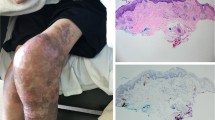Summary
The pattern of X-chromosome inactivation was analyzed, by means of two different DNA probes (pSPT-PGK and M27β), in several cell lineages derived from females belonging to a pedigree with X-linked immunodeficiency with hyper-IgM (HIGM1). Non-random X-chromosome inactivation was demonstrated in T cells, B cells, and neutrophils, but not in fibroblasts, of obligate carriers, suggesting that different hematopoietic cell lineages are primarily involved in HIGM1. Preferential inactivation of the paternally derived X-chromosome was demonstrated by analysis of segregation of the alleles defined by the pSPT-PGK and M27β probes. The possibility that the HIGM1 mutation may confer a proliferative and/or differential advantage to hematopoietic precursors carrying the mutated allele on the active X-chromosome is discussed.
Similar content being viewed by others
References
Boyd Y, Fraser N (1990) Methylation patterns at the hypervariable X-chromosome locus DXS255 (M27β). Correlation with X-inactivation status. Genomics 7:182–187.
Camerino G, Grzeschik KH, Jaye M, La Salle H de, Tolstoshev P, Lecoq JP, Heilig R, Mandel JL (1984) Regional localization on the human X chromosome and polymorphism of coagulation factor IX gene (hemophilia B locus). Proc Natl Acad Sci USA 81:498–502.
Conley ME, Puck JM (1988b) Carrier detection in typical and atypical X-linked agammaglobulinemia. J Pediatr 112:688–694.
Conley ME, Puck JM (1988c) Definition of the gene loci in X-linked immunodeficiencies. Immunol Invest 17:425–463.
Conley ME, Brown P, Pahwa S, Puck IM (1988a) An intrinsic B cell defect in X-linked hyper IgM syndrome. Pediatr Res 23:353A.
Eibl M, Griscelli C, Seligman M, Aiuti F, Kishimoto T, Matsumoto S, Hanson L, Hitzig WH, Thompson RA, Cooper MD, Good RA, Rosen FS, Waldmann TA, Wedgwood RJ (1989) Primary immunodeficiency diseases. Report of a WHO sponsored meeting. Immunodeficiency Rev 1:173–205.
Fearon ER, Kohn DB, Winkelstein JA, Vogelstein B, Blaese RM (1988) Carrier detection in the Wiskott Aldrich syndrome. Blood 72:1735–1739.
Feinberg AP, Vogelstein B (1983) A technique for radiolabeling DNA restriction endonuclease fragments to high specific activity. Anal Biochem 132:6–13.
Geha RS, Hyslop N, Alami S, Farah F, Schneeberger EE, Rosen FS (1979) Hyper immunoglobulin M immunodeficiency (dysgammaglobulinemia). J Clin Invest 64:385–391.
Goldman AS, Ritzmann SE, Houston EW, Sidwell S, Bratcher R, Levin WC (1967) Dysgammaglobulinemia antibody deficiency syndrome: increased gamma-M globulins and decreased gamma-G and gamma-A globulins. J Pediatr 70:16–27.
Goodship J, Malcolm S, Lau YL, Pembrey ME, Levinsky RJ (1988) Use of X chromosome inactivation to establish carrier status for X-linked severe combined immunodeficiency. Lancet I:729–732.
Krantman HJ, Stiehm ER, Stevens RH, Saxon A, Seeger RC (1980) Abnormal B cell differentiation and variable increase of T cell suppression in immunodeficiency with hyper-IgM. Clin Exp Immunol 40:147–156.
Levitt D, Haber P, Rich K, Cooper MD (1983) Hyper IgM immunodeficiency. A primary dysfunction of B lymphocyte isotype switching. J Clin Invest 72:1650–1653.
Maccario R, Nespoli L, Mingrat G, Vitiello A, Ugazio AG, Burgio GR (1983) Lymphocyte subpopulations in the neonate: identification of an immature subset of OKT8-positive, OKT3-negative cells. J Immunol 130:1129–1131.
Malcolm S, De Saint Basile G, Arveiler B, Lau YL, Szabo P, Fischer A, Griscelli C, Debre M, Mandel JL, Callard RE, Robertson ME, Goodship GA, Pembrey ME, Levinsky RJ (1987) Close linkage of random DNA fragments from Xq21.3–22 to X-linked agammaglobulinemia (XLA). Hum Genet 77:172–177.
Mayer L, Kwan SP, Thompson C, Ko HS, Chiorazzi N, Waldmann T, Rosen FS (1986) Evidence for a defect in “switch” T cells in patients with immunodeficiency and hyperimmunoglobulinemia M. N Engl J Med 314:409–414.
Mensinck EJBM, Thompson A, Sandkuyl LA, Kraakman EM, Schoot JDL, Espanol T, Schuurman RKB (1987) X-linked immunodeficiency with hyperimmunoglobulinemia M appears to be linked to the DXS42 restriction fragment length polymorphism locus. Hum Genet 76:96–99.
Migeon BR, Axelman J, Stetten G (1988) Clonal evolution in human lymphoblast cultures. Am J Hum Genet 42:742–747.
Singer-Sam J, Keith DH, Tani K, Simmer RL, Shively L, Lindsay S, Yoshida A, Riggs AD (1984) Sequence of the promoter region of the gene for human X-linked 3-phosphoglycerate kinase. Gene 32:409–417.
Stiehm ER, Fudenberg HH (1966) Clinical and immunological features of dysgammaglobulinemia type I. Report of a case diagnosed in the first year of life. Am J Med 40:805–815.
Vogelstein B, Fearon ER, Hamilton SR, Preisinger AC, Willard HF, Michelson AM, Riggs AD, Orkin SH (1987) Clonal analysis using recombinant DNA probes from the X-chromosome. Cancer Res 47:4806–4813.
Author information
Authors and Affiliations
Rights and permissions
About this article
Cite this article
Notarangelo, L.D., Parolini, O., Albertini, A. et al. Analysis of X-chromosome inactivation in X-linked immunodeficiency with hyper-IgM (HIGM1): evidence for involvement of different hematopoietic cell lineages. Hum Genet 88, 130–134 (1991). https://doi.org/10.1007/BF00206059
Received:
Revised:
Issue Date:
DOI: https://doi.org/10.1007/BF00206059




